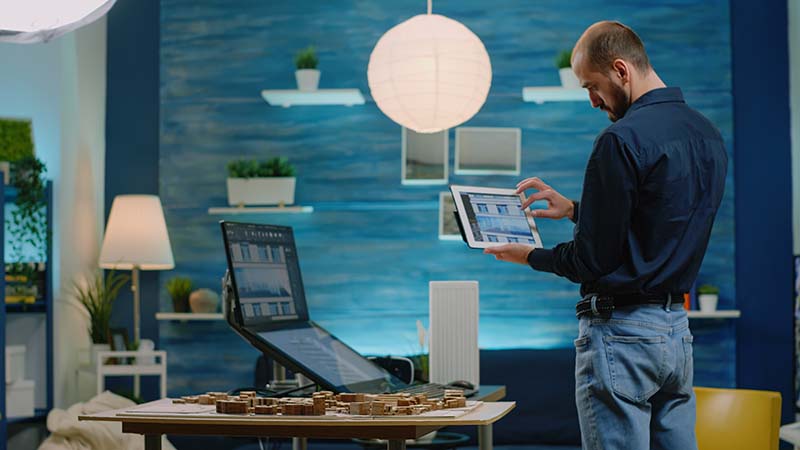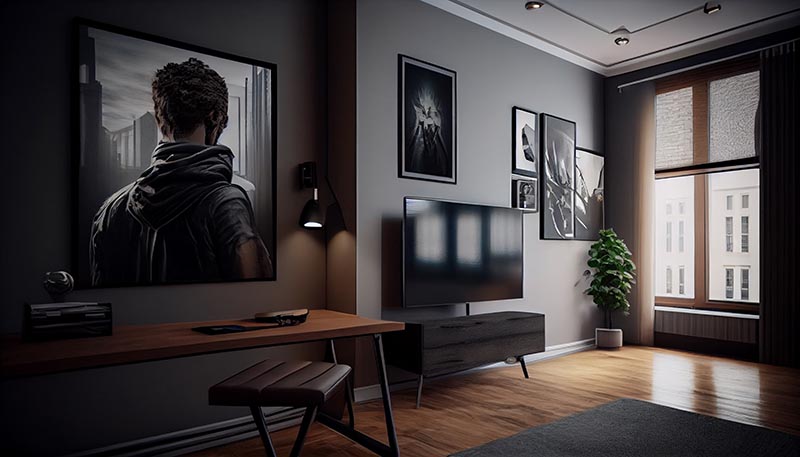Imagine stepping into a room where walls can communicate, and every piece of furniture anticipates your needs. It sounds like a scene from a sci-fi movie, doesn’t it? No, this is the future: AI interior design. Let’s explore artificial intelligence’s role in revolutionizing how we design and experience our homes, offices, and public spaces.
What is AI in Interior Design?

Source: Freepik
Artificial Intelligence (AI) in interior design refers to the use of computer systems and algorithms that imitate human thinking. They are used to make independent decisions and help designers create innovative spaces. This lets them leverage data analysis, pattern recognition, and machine learning for improved creativity and enhanced design processes.
AI in interior design does more than just automation. It provides interior designers with intelligent insights, recommendations, and customized solutions. This is done specifically to suit their client’s individual preferences and needs for functionality.
Enhancing the Design Process with AI

As with so many industries, AI is revolutionizing the design process with powerful tools and insights. These help interior designers augment their creativity and efficiency. Below are two ways AI helps with the process:
- AI helps designers with generating ideas and concepts. It can analyze vast amounts of data that can find patterns and connections that inspire new design concepts. It offers unique design suggestions that designers may not have thought of before. Designers can now use these ideas and concepts as starting points that they can further develop and enhance. This results in more personalized and distinct designs.
- AI allows for virtual testing and immersive design experiences. AI-powered technologies such as virtual reality (VR) and augmented reality (AR) allow designers and their clients to view and experience designs even before they are created. Clients can get a feel of an environment through virtual reality, wherein they can also explore and interact with the spaces.
Intelligent Spaces: AI’s Impact on the Built Environment

AI is truly transforming the way we experience and interact with the built environment. Thanks to this technology, we can create more intelligent spaces that are responsive to our needs. AI is shaping these spaces by way of adaptive lighting and ambiance control.
AI-powered systems can adjust lights and ambiance in real-time by using the following factors as their base: occupancy, natural light levels, and user preferences. This intelligent control ensures the best lighting conditions for various activities. It enhances energy efficiency by minimizing unnecessary lighting.
It also creates customized atmospheres that cater to individual preferences. It has the ability to dim the lights for a cozy movie night or brighten up a workspace for an extra boost of productivity. In short, AI can adapt lighting and ambiance to create the desired mood and functionality.
In addition, AI lets designers integrate smart furniture and responsive interior elements that adapt to their client’s needs. AI sensors can detect a user’s body posture and adjust a furniture’s ergonomics to provide optimum comfort. Also, intelligent surfaces and materials can change their properties, such as transparency and temperature, to conform to the user’s preferences or environmental conditions.
All these intelligent features enhance user experience while promoting well-being and optimizing space use. Thanks to AI in interior design, the built environment has become more dynamic, intuitive, and customized to the individual’s needs.
The Human Element: Balancing AI and Creativity

Some might think that the use of AI in interior design will become robotic and lifeless. This is the reason AI can never do it alone. It has to have the perfect balance of technology and the human touch. AI brings helpful tools and efficiency to the table, but we must never forget the value of the human touch. Interior designers have the unique ability to add emotion, personal experiences, and imaginative thinking to their designs. This is the exact moment AI can never replicate.
Therefore, a good balance of AI’s powers and human creativity will be the best solution for creating truly inspiring and captivating spaces.
Creativity thrives on imagination, exploration, and thinking outside of the box. AI can be useful if you need to spark an idea or expand a design possibility, but it can’t do the job by itself. It can analyze data and give you insights, update you with trends, or offer alternative suggestions. However, the artistic vision and individual style still rest on the designer.
Examples of AI Interior Design Apps
If you want to try the fantastic possibilities that AI interior design apps offer, below are a few notable examples you can check out:
Houzz
A popular interior design app, Houzz uses AI to help users discover design ideas and connect with interior design professionals. It has a massive collection of images that you can use for virtual viewings through augmented reality.
Planner 5D
An AI-powered interior design app, Planner 5D lets users create detailed floor plans and 3D visualizations of their dream spaces. It has an extensive library of furniture, decor, and many other materials. Its AI algorithms offer suggestions based on user preferences.
Morpholio Board
Aiming to assist interior designers with creating and presenting design concepts, Morpholio Board uses AI algorithms to curate and organize visual references and mood boards. Plus it generates product suggestions based on the user’s desired aesthetics.
Roomstyler 3D Home Planner
An AI interior design app, Roomstyler 3D Home Planner, lets users design and visualize their spaces in 3D. Its user-friendly interface allows users to explore and experiment with different furniture arrangements, colors, and materials.
Home Design 3D
An AI-based interior design app, Home Design 3D helps users create floor plans and design their interiors. It offers various pieces of furniture that are customizable and many other decor options. It provides suggestions for placements and design improvements.
Final Thoughts
AI is now playing a significant role in transforming interior design. It has immense potential for shaping the future of the industry. AI-powered technologies such as virtual reality, augmented reality, machine learning, and many others are revolutionizing the way designers create, visualize, and interact with spaces.
